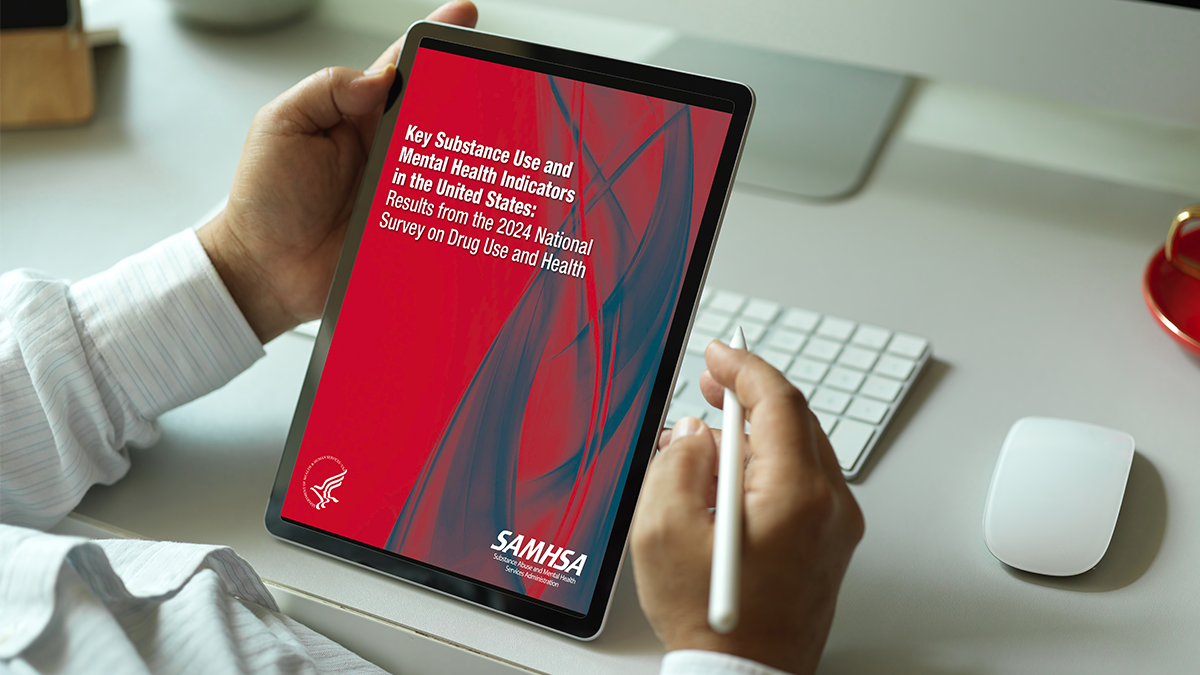Mental health, substance misuse, addiction, and their related health and social impacts such as overdose and suicide are dynamic and evolving.
With the ready availability of illicitly made fentanyl and other potent synthetic opioids such as nitazenes, the emergence of substances like xylazine, medetomidine, and illicit benzodiazepines, and increasing polysubstance use, Americans face an illicit drug supply that is more toxic, unpredictable, and dangerous than ever. In addition, the proliferation of social media and other technology that is inundating America’s young people coupled with other social stressors in homes and communities across the Nation have contributed to declining mental health and well-being and rising rates of suicide in the past two decades.
We know that mental health and substance use conditions are part of the chronic disease crisis plaguing our nation. Research shows that substance misuse and early health risk behaviors that take root during childhood and adolescence are closely linked to risk for chronic disease, substance use disorders, and mental health conditions later in life and contribute to a significant proportion of the health and social costs associated with chronic disease. By addressing mental health and substance misuse head-on through a comprehensive approach in partnership with states, communities, and tribes, we can help to achieve the Administration’s goal of Making America Health Again (MAHA) (PDF | 3.8 MB).
As we embark on a bold new path to MAHA, having timely data to inform policy, program and practice are essential. For more than four decades, SAMHSA’s National Survey on Drug Use and Health (NSDUH) has been the federal government’s trusted source of information on substance use and mental health.
Today, SAMHSA is releasing the 2024 NSDUH results which provide key insights into the latest trends and patterns of substance use and mental health among Americans. Of note, the 2024 NSDUH marks the first year since 2020 in which there are at least four years of comparable data for key NSDUH outcomes, enabling reporting of trends from 2021 to 2024 for many substance use and mental health measures. Linear tests of were conducted to determine whether an outcome of interest showed a statistically significant change from 2021 through 2024.
Today’s release represents the earliest release of the annual NSDUH report, delivering on the Trump Administration’s promise of greater efficiency and transparency in data-driven policy making. Detailed below are some of the key findings from the 2024 NSDUH. Additional information, data, and resources can be found on the NSDUH webpage.
Substance Use Among Americans 12 Years or Older
Alcohol, nicotine and marijuana remain the most commonly used substances among Americans (Figure 1). In 2024, 134.3 million people aged 12 years or older reported using alcohol in the past month, followed by 48.0 million using tobacco products, 44.3 million using marijuana, and 27.7 million vaping nicotine.
Figure 1. Number of Americans 12 Years or Older Reporting Past Month Use of Specific Substances, 2024

In 2024, approximately 1 in 4 Americans 12 years or older (73.6 million; 25.5%) reported illicit drug use in the past year (Figure 2). This included 64.2 million that reported past year use of marijuana, 10.4 million that used hallucinogens, 7.6 million misusing prescription opioids, 4.6 million misusing prescription tranquilizers or sedatives, and 4.3 million using cocaine.
Figure 2. Number of Americans 12 Years or Older Reporting Use of Specific Illicit Drugs in the Past Year, 2024

In addition to past month and past year use, NSDUH captures the number of people in the U.S. who reported using specific drugs, alcohol, or nicotine for the first time in the past year (Figure 3). Nicotine vaping (5.4 million new initiates), alcohol use (4.2 million new initiates), and marijuana use (2.9 million new initiates) were most common substances. These annual numbers translate to approximately 14,800 new users of nicotine vaping, 11,500 new users of alcohol, 7,900 new users of marijuana each day in 2024.
Figure 3. Past Year Initiates of Specific Substances Among People 12 Years or Older, 2024

Substance Use Disorders Among Americans 12 Years or Older
In 2024, nearly 50 million Americans, 16.8% of people 12 years or older, met diagnostic criteria for a substance use disorder in the past year (Figure 4). Of these individuals, 27.9 had an alcohol use disorder, 28.2 million had a drug use disorder. About 1 in 6 people with a past year substance use disorder (16.0% or 7.7 million people) had both an alcohol use disorder and a drug use disorder in the past year. Marijuana use disorder was the most common drug use disorder (20.6 million), followed by opioid use disorder (4.8 million), and central nervous system stimulant use disorder (4.3 million)
Figure 4. Past Year Substance Use Disorders Among People 12 Years or Older, 2024

Mental Health Among Adults 18 Years or Older
For the first time in 2024, the NSDUH included the Generalized Anxiety Disorder (GAD-7) scale, a validated self-report measure to screen for and assess symptoms of GAD in the past two weeks. Among adults 18 years or older in the U.S., 7.4% had moderate or severe symptoms of anxiety and 14.3% had mild symptoms (Figure 5). Moderate to severe symptoms were more common among 18 to 25 year-olds (14.5%) compared to 26 to 49 year-olds (9.0%) and adults 50 years or older (3.9%).
Figure 5. Generalized Anxiety Symptom Severity in the Past 2 Weeks Among Adults 18 Years Older, 2024

Among adults 18 years or older, 8.2% (21.4 million) had a past year major depressive episode (MDE). The percentage of adults aged 18 or older who had a past year MDE with severe impairment was 5.6% (14.7 million). As with generalized anxiety disorder symptoms, a larger percentage of adults 18 to 25 years old had MDE and MDE with severe impairment (15.9% and 11.5%, respectively) compared to adults aged 26 to 49 (10.0% and 7.0%) and 50 or older (4.4% and 2.6%).
About 1 in 4 adults 18 years or older (23.4%; 61.5% million) had any mental illness (AMI) in the past year (Figure 6). The percentage of adults 18 to 25 years old with AMI was 33.2%, followed by 29.7% of adults 26 to 49 years old, and 15.2% of adults 50 or older. In 2024, 5.6% (14.6 million) of adults aged 18 years or older had serious mental illness (SMI) in the past year. Among adult age groups, SMI was highest among 18 to 25 year olds (9.4%), followed by 26 to 49 year olds (7.5%), and adults 50 years or older (2.8%).
Figure 6. Percentage of Adults with Any Mental Illness and Serious Mental Illness in the Past Year, 2024

Suicidal Thoughts, Plans, and Attempts Among Adults
Among adults 18 years or older in 2024, 5.5% (14.3 million) reported serious thoughts of suicide in the past year, 1.8% (4.6 million) made a suicide plan, and 0.8% (2.2 million attempted suicide (Figure 7).
Figure 7. Suicidal Thoughts, Plans, and Attempts Among Adults, 2024

Adolescent Mental Health
Among adolescents aged 12 to 17 in 2024, about 1 in 5 (18.8%; 4.9 million) had moderate or severe symptoms of GAD; about 1 in 4 adolescents (23.1%; 6.0 million) had mild symptoms (Figure 8).
Figure 8. Generalized Anxiety Symptom Severity in the Past 2 Weeks Among Adolescents Aged 12 to 17 Years Old, 2024

Among adolescents aged 12 to 17, 15.4% (3.8 million) had a past year MDE and 11.3% (2.8 million) had a past year MDE with severe impairment in 2024 (Figure 9).
Figure 9. Number of Percentage of Adolescents with Major Depressive Episode and Major Depressive Episode with Severe Impairment, 2024

In 2024, 2.6 million (10.1%) adolescents reported serious thoughts of suicide, 1.2 million (4.6%) made a suicide plan, and 700,000 (2.7%) attempted suicide (Figure 10).
Figure 10. Suicidal Thoughts, Plans, and Attempts Among 12 to 17 Years Old, 2024

Treatment for Substance Use Disorders and Mental Illness
In 2024, approximately 1 in 5 people (19.3%) who needed substance use treatment, actually received treatment in the past year. Treatment receipt was highest among adolescents aged 12 to 17 years (30.2% of those needing treatment reported receiving treatment in the past year), followed by those 26 years or older (20.5%) and those 18 to 25 years old (11.3%) (Figure 11).
Figure 11. Receipt of Substance Use Treatment in the Past Year Among People Aged 12 or Older Who Needed Substance Use Treatment in the Past Year, 2024

In 2024, among adults with any mental illness and those with serious mental illness in the past year, most received mental health treatment in the past year. Overall, 52.1% of adults with any mental illness and 70.8% of those with serious mental illness reported receiving mental health treatment in the past year (Figure 12).
Figure 12. Receipt of Mental Health Treatment in the Past Year Among People Adults 18 or Older with Any Mental Illness or Serious Mental Illness in the Past Year, 2024

Among the 3.8 million adolescents aged 12 to 17 in 2024 that had a past year major depressive episode, 60.6% (2.3 million) reported receiving mental health treatment in the past year (Figure 13).
Figure 13. Types and Locations of Mental Health Treatment in the Past Year Among Adolescents Aged 12 to 17 with a Past Year Major Depressive Episode (MDE), 2024

In 2024, among adults 18 or older, 12.2% (31.7 million) perceived they ever had a problem with their use of drugs or alcohol. Among these adults, 74.3% (23.5 million) considered themselves to be in recovery or to have recovered from their drug or alcohol use problem. Similarly, 26.1% of adults (67.8 million) perceived they ever had a problem with their mental health. Among these adults, 66.9% (45.0 million) considered themselves to be in recovery or to have recovered from their mental health issue (Figure 14).
Figure 14. Substance Use and Mental Health Recovery Among Adults 18 Years or Older, 2024

Key Substance Use and Mental Health Trends From 2021 to 2024
Among people 12 years or older, based on linear trend testing, most key outcome measures either decreased or remained stable between 2021 and 2024 (Figure 15).
Figure 15. Key Substance Use and Mental Health Trends from 2021 to 2024

Using the 2024 NSDUH To Drive Policy, Program, and Practice Strategies
The 2024 NSDUH identifies areas of progress in our work to address substance use and mental illness as well as key opportunities as we move forward our MAHA agenda and goals.
On the progress front, we see from the NSDUH that the percentage of people 12 years or older reporting use of most substances either decreased or remained stable between 2021 and 2024, with decreases in past month use of tobacco, cigarettes, binge and heavy drinking as well as decreases in past year use of cocaine, misuse of prescription opioids, and past year alcohol use disorder.
We also saw declines in a number of adolescent mental health measures between 2021 and 2024, including major depressive episode with and without severe impairment, co-occurring major depressive episode and substance use disorder, and all three measures of suicide – serious thoughts of suicide, suicide plans, and suicide attempts.
In addition, the high percentage of American adults that report being in recovery – 74.3% of those who perceived they ever had a problem with their use of drugs or alcohol and 66.9% of those who perceived they ever had a problem with their mental health – is a statistic to highlight and to help spread hope about the power and healing of recovery.
But the NSDUH also identifies trends heading in the wrong direction. This includes past year illicit drug use, marijuana use, and hallucinogen use and past year drug use disorder and marijuana use disorder. Among adults, we also saw that the percentage of people 18 or older that reported making a suicide plan increased between 2021 and 2024.
Of note, the increases in past-year illicit drug use and past-year drug use disorders are largely driven by increases in marijuana use and marijuana use disorder among adults 26 years or older. Although marijuana use and use disorder trends remained stable among adolescents and young adults between 2021 and 2024, the increase in adult use is important to inform prevention and treatment activities given changing attitudes around marijuana use and the shifting state policy landscape which has increased risk for marijuana use and use disorder among young people, and enabled the ready availability of high-potency marijuana products linked to negative health impacts in communities across the country.
A key pattern that has emerged in recent years is the prominence of vaping, especially among young people. In the 2024 NSDUH we find that among past month users of tobacco or nicotine products, 71.5% of 12 to 17 year-olds and 50.3% of 18 to 25 year-olds reported only vaping nicotine in contrast to 18.0% among adults 26 or older. For past month users of marijuana, 71.1% of 12 to 17 year-olds and 52.0% of 18 to 25 year-olds reported vaping marijuana compared to 33% among those 26 or older (Figure 16).
Figure 16. Routes of Nicotine and Marijuana Use Among Past-Month Users of Each Substance, 2024


The NSDUH also highlights the substantial overlap between substance use and mental health. Although mental health and substance use funding and treatment systems have historically often been separate, the NSDUH clearly demonstrates that in reality, people with substance use disorders and those with mental health challenges often have co-occurring conditions.
For both adults and adolescents with mental health challenges, the prevalence of substance use is higher compared to those without mental health challenges. As shown in Figure 17, whether it is adolescents with major depressive episode or moderate or severe anxiety symptoms, the prevalence of each substance use measure is significantly higher among those with mental health challenges.
Figure 17. Prevalence of Substance Use Among Adolescents 12 to 17 by Mental Health Status, 2024


The same is true for adults with any mental illness and serious mental illness as well as adults with moderate or severe anxiety symptoms (Figure 18).
Figure 18. Prevalence of Substance Use Among Adults 18 or Older by Mental Health Status, 2024


We see a similar pattern when we look at the overlap of substance use disorders and any mental illness and serious mental illness (Figure 19). Among the 61.5 million adults with any mental illness in the past year in 2024, 21.2 million (34.5%) also had a substance use disorder. Among the 14.6 million adults with serious mental illness in the past year in 2024, 6.9 million (47.3%) also had a substance use disorder. Among the 46.3 million adults with a substance use disorder in the past year in 2024, 45.8% had any mental illness and 14.9% had serious mental illness.
Figure 19. Any Mental Illness, Serious Mental Illness, and Substance Use Disorder Among Adults 18 or Older, 2024

The final opportunity clearly identified in the 2024 NSDUH is the need to increase access to and utilization of treatment for substance use disorders and mental illness. The statistics are clear – 80% of people who needed treatment for a substance use disorder in 2024 did not get treatment. Although the gap for mental health treatment receipt is better – 40% of adolescents with major depressive episode did not receive treatment along with 48% of adults with any mental illness and 30% of adults with serious mental illness not receiving mental health treatment in the past year, there are opportunities to close this treatment gap.
And as we work together to improve access to treatment, we have to be strategic and intentional in developing systems of care that will meet the needs of individuals with behavioral health conditions, recognizing that more often than not, people struggling with mental health issues also have substance use challenges and those with substance use challenges also have mental health challenges. Yet, despite data showing this to be the case, we see that both adolescents and adults with substance use and mental health conditions rarely receive treatment for both.
For example, among adolescents with major depressive episode and substance use disorder in 2024, 27.9% received no treatment, and only a small percentage, 18.1% received both substance use and mental health treatment. Most often, 53.0% these adolescents only received mental health treatment (Figure 20).
Figure 20. Receipt of Substance Use Treatment or Mental Health Treatment in the Past Year Among Adolescents Aged 12 to 17 with Past Year Substance Use Disorder and Major Depressive Episode, 2024

A similar pattern emerges for adults with substance use disorder and any mental illness. In 2024, among the 21.2 million adults with co-occurring mental illness and substance use disorder, 41.2% received neither substance use or mental health treatment and only 14.5% received treatment for both substance use and mental health. As with adolescents, mental health treatment but not substance use treatment (41.0%) was most common (Figure 21).
Figure 21. Receipt of Substance Use Treatment or Mental Health Treatment in the Past Year Among Adults 18 or older with Past Year Substance Use Disorder and Any Mental Illness, 2024

The reality is we are facing unique addiction and mental health challenges in our country. But we have the data, tools, and resolve to get ahead of these challenges. By addressing mental health and addiction head-on we can make real, tangible progress in achieving our MAHA goals and realize a future where individuals, families, and communities are healthy and thriving.
At SAMHSA, we are committed partners in this effort and our work will continue to strategically leverage our data, expertise, resources, training, and technical assistance to:
- Identify and address emerging behavioral health threats
- Prevent substance misuse in the first place
- Promote mental health and well-being
- Expand crisis intervention care and services
- Improve access to treatment for mental health and substance use conditions
- Help individuals achieve long-term recovery
Conducted by the federal government since 1971, the NSDUH is a primary source of statistical information on self-reported substance use and mental health. The NSDUH report provides nationally representative data on the self-reported use of tobacco, alcohol, and illicit drugs; substance use disorders; mental health conditions; suicidal thoughts and behaviors; and substance use and mental health treatment and recovery among the civilian, noninstitutionalized population aged 12 or older in the United States. The annual NSDUH report is a statistical product from SAMHSA’s Center for Behavioral Health Statistics and Quality, one of 16 Federal Statistical Units.










